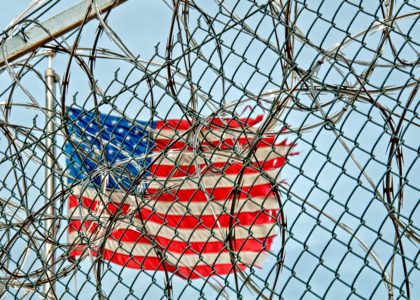By: Jose Gomez
Access to education is rarely available to incarcerated people in the United States. It is also one of the only documented solutions to recidivism, which is the rate at which formerly incarcerated individuals return to prison following their release. On average, only 35 to 42 percent of state prisons provide college courses. Even with this, only a meager 6 percent of incarcerated individuals attend these classes, exposing either a lack of resources to reach more people or a lack of incentives to do so. [1] This severely limits the preparation that incarcerated people can receive to better themselves, and makes poor use of their time if they choose to study for future home or employment prospects.
One of the many obstacles to receiving education behind bars is that many incarcerated people do not have the money to attend courses. Before its ban in the 1994 Crime Bill, the Federal Pell Grant was also offered to incarcerated individuals and operated around 300 educational programs nationwide. After the ban, that number went down to 12. [2] Although the ban was finally lifted earlier this year, the Federal Pell Grant has only been offered to a handful of programs, and many of these same facilities still rely on “charg[ing] students tuition, receiv[ing] state funding],” and attracting philanthropies to sustain their programs. [3]
There have been many successful examples of prison education, however. Before the ban was lifted, around 65 colleges participated in the 2015 Second Chance Pell Grant program, which overrode the ban to research the benefits of providing grants to incarcerated individuals determined to learn. [3] Since the ban was lifted just this year, providing the Pell Grant to incarcerated individuals was proven to reduce recidivism and improve inmates’ behavior, both in prison and after release, which reduces prison operation costs for state governments.
Successful prison education programs do exist in this country, even though it is difficult to maintain them. Based in Ohio’s correctional facilities, Sinclair Community College’s (SCC) prison education program has run for over 31 years, which has allowed “incarcerated men and women an opportunity to earn certificates—and associate degrees at one point.” [3] Their program gets reimbursed up to $2000 per student by the state’s corrections department with the federal government bestowing to SCC “more than 1,300 Pell Grants,” 600 of which are already in use. [3]
The most surprising statistic—and the one that provides the most incentive for state governments—is the amount of savings SCC manages to accumulate in just a year. Research has concluded that from Ohio’s cost of incarceration and recidivism rate, their prison education programs save the state around $33 million. [3] Sinclair is not an anomaly, though. On average, government-funded prison education tends to increase employment rates across the states by around 10 percent, which translates to “nearly [a] $45.3 million increase in combined earnings of workers during the calendar year of their release.” [4] When these savings are taken into account along with the benefits of preparing formerly incarcerated people to face the outside world, it’s surprising that prison education programs aren’t widely implemented in the prison rehabilitation process in the U.S.
It’s important to note that these educational programs do not simply spring from thin air. Many are the product of mission statements and clear goals to which non-profits and correctional facilities can hold themselves accountable. A clear mission is one of the components to the development of prison educational programs where institutions can build upon their “policies, procedures, and processes that promote and strengthen” the livelihood prospects of participating individuals. [1] Our mission is simple: to educate incarcerated veterans with the tech skills they’ll need in the information technology sector. Other missions may be grounded on things like bettering prison behaviors or GED completion, but whatever the mission may be, it’s paramount for the program to help incarcerated individuals progress through their academic achievements.
Additionally, memorandums of understanding (MOUs) can help keep the connection between these institutions. Simply put, a memorandum of understanding is a document that commits the organizations involved with the said mission statement, which they can come back to regularly. Though this document is not legally enforceable, the two parties essentially merge their objectives in a manner that binds both their word and reputation if breached.
Other forms of collaboration include cross-training staff members, which is key to understanding the limits imposed by prison staff and their impact on the educational goals of incarcerated individuals. As for cross-training, this involves corrections and security officers, housing, staff, visitors, and educators in the facility, a process that helps create a familiarity with the security measures taken by prison staff to guard the incarcerated. Else, “[outside] instructors may misinterpret corrections staff’s adherence to facility rules as lack of support for the project, potentially alienating people who may otherwise support the program and its goals.” [5]
An example of one such misinterpretation occurs when incarcerated individuals have the opportunity to study while behind bars while the prison staff does not have access to that same opportunity, which creates resentment. To curb this sentiment, cross-training is also meant to share the materials, experiences, and learning available among the people involved. This fosters an environment where both the incarcerated and the staff can benefit from a prison education program.
Cross-training involves things like a tour of the facility, listing prohibited items, making clear how materials can be obtained, and mandatory courses for volunteers, among other things. Thus, comprehensive cross-training for members from both parties establishes how a particular course can be given without misunderstanding or delays to the curriculum, benefitting participating students by providing them the most efficient form of learning available to them.
Although the number of incarcerated individuals who haven’t attended college has only increased throughout the years, it’s only a matter of time before state governments start to adopt education as a more permanent part of the civil reentry process. [1] SCC and other participant colleges have already proven that their programs are a benefit to society as a whole—the research is there. Now it is just a matter of becoming vocal about this solution to our state governments, who have control over the funds and approval of such programs. We at Project Reclass are doing our part to serve and educate incarcerated veterans, but there must be a greater public push toward the creation of new programs for all.
[1] New York: Vera Institute of Justice. (2015, December). Building Effective Partnerships and Programs for High-Quality Postsecondary Education in Correctional Facilities. Retrieved October 29, 2021, from https://www.vera.org/downloads/publications/EAPSE-Factsheet-v5.pdf.
[2] Burke, L. (2021, January 27). With Pell Grants restored to people in prison, eyes turn to assuring quality. Retrieved October 29, 2021, from https://www.insidehighered.com/news/2021/01/27/pell-grants-restored-people-prison-eyes-turn-assuring-quality.
[3] Smith, A. A. (2018, November 6). Colleges push for more resources to support prison education programs. Retrieved October 29, 2021, from https://www.insidehighered.com/news/2018/11/06/colleges-push-more-resources-support-prison-education-programs.
[4] Oakford, P., Brumfield, C., Goldvale, C., Tatum, L., diZerega, M., & Patrick, F. (2019, January). Investing in Futures: Economic and Fiscal Benefits of Postsecondary Education in Prison. Retrieved October 29, 2021, from https://www.vera.org/downloads/publications/investing-in-futures.pdf.
[5] Delaney, R., Subramanian, R., & Patrick, F. (2016). Making the Grade: Developing Quality Postsecondary Education Programs in Prison. New York: Vera Institute of Justice. Retrieved October 29, 2021, from https://www.vera.org/downloads/publications/making-the-grade-postsecondary-education-programs-in-prison.pdf.
The Author

José Gomez is an undergraduate at UChicago with an interest in economics and political science. Seeking a future career in immigration law, he is passionate about increasing awareness of migrants down at the border. José enjoys volunteering, running alongside Lake Michigan, and reading history books.





